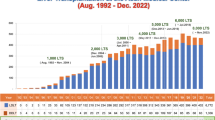Summary
BACKGROUND: Living-donor liver transplantation (LDLT) has become a feasible treatment option for adults with end-stage liver diseases. This is seen as a result of technical evolution in hepatobiliary surgery and increased experience with split-liver grafts. METHODS: From August 1998 to May 2004, 98 adult-to-adult LDLT were performed at the University of Essen. Primary diagnosis was tumor disease in 45 patients, post-hepatitic cirrhosis in 25 patients, and other chronic liver diseases in 28 patients. 42 patients (43%) fulfilled the criteria of the "extended indication". RESULTS: The overall 1-year patient and graft survival rates were 75.2 and 69.2%, respectively. The overall 3-year patient and graft survival rates were 72.7 and 66.7%, respectively; this included all recipients with extended indications. CONCLUSIONS: The critical issue of LDLT remains the donor morbidity, as we lost one donor due to a preoperatively unrecognized congenital lipodystrophy. Graft and patient survival in all patients clearly indicate the benefits of LDLT for patients exceeding the listing criteria.
Zusammenfassung
GRUNDLAGEN: Die Lebendleber-Transplantation (LDLT) ist eine klinisch etablierte Behandlungmethode vieler chronischer Lebererkrankungen im Endstadium. Dies wurde unter anderem durch die kontinuierliche Weiterentwicklung chirurgischer Techniken im Rahmen der hepatobiliären Chirurgie und Erfahrungen aus dem Bereich der Split-Leber-Transplantation ermöglicht. METHODIK: Von August 1998 bis Mai 2004 wurden am Universitätsklinikum Essen 98 LDLT bei erwachsenen Empfängern durchgeführt. Bei 45 Patienten war ein Lebermalignom die primäre Diagnose, eine post-hepatitische Zirrhose bestand bei 25 Patienten, 28 Patienten hatten andere chronische Lebererkrankungen. 42 Patienten (43 %) erfüllten die Kriterien der "erweiterten Indikation" zur Transplantation. ERGEBNISSE: Die 1-Jahres-Patienten und -Transplantat-Überlebensrate betrug 75,2 % und 69,2 %. Die 3-Jahres-Patienten und -Transplantat-Überlebensrate betrug 72,7 % und 66,7 %, unabhängig von der Grunderkrankung. SCHLUSSFOLGERUNGEN: Der limitierende Aspekt der LDLT bleibt weiterhin die Spendermorbidität. Die Patienten- und Transplantat-Überlebensraten aller Patienten zeigen eindrucksvoll einen klaren Vorteil für Patienten, die auf der herkömmlichen Warteliste zur Transplantation keine Chance haben.
Similar content being viewed by others
Author information
Authors and Affiliations
Corresponding author
Rights and permissions
About this article
Cite this article
Frühauf, N.R., Malagó, M., Frilling, A. et al. Living-donor liver transplantation in adults: single-center experience. Eur Surg 36, 296–299 (2004). https://doi.org/10.1007/s10353-004-0091-6
Issue Date:
DOI: https://doi.org/10.1007/s10353-004-0091-6




